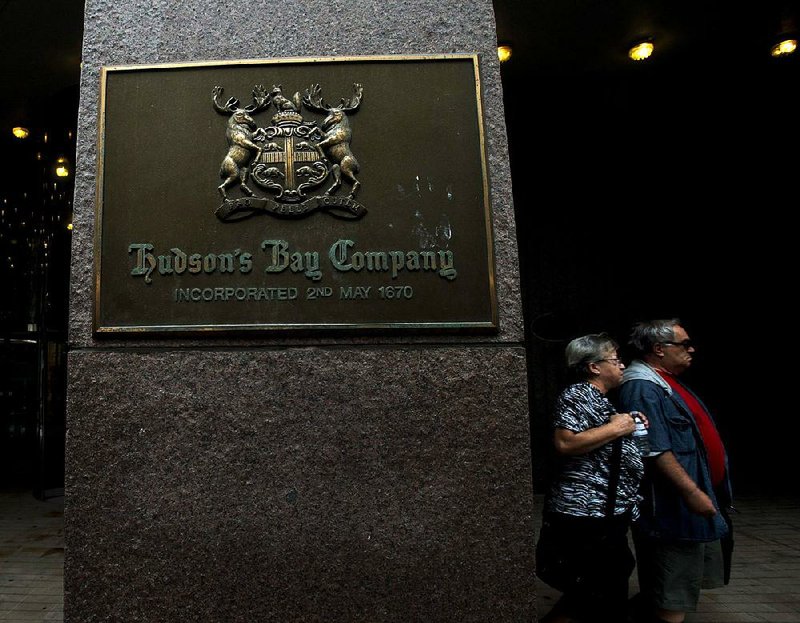NEW YORK - Saks Inc. has agreed to be bought by Hudson’s Bay Co., the Canadian parent of retailer Lord & Taylor, for about $2.4 billion in a deal that will bring luxury to more North American locales.
The acquisition combines three department-store brands - Hudson’s Bay, Lord & Taylor and Saks Fifth Avenue - and creates a North American upscale retailing behemoth with 320 stores in some of the biggest and most populous cities in the U.S. and Canada.
Lord & Taylor and Hudson’s Bay, Canada’s biggest department store chain, both cater to well-heeled shoppers who can afford $98 Free People blouses and $250 Coach handbags. Saks customers, on the other hand, are typically more affluent and can shell out $800 for Christian Louboutin heels or a couple thousand dollars for Gucci handbags.
During a conference call with investors on Monday, Hudson’s Bay Chairman and Chief Executive Officer Richard Baker said that the goal is to bring up to seven Saks Fifth Avenue stores and 25 Off Fifth outlet stores to Canada, while creating a Saks website targeted to Canadians. Hudson’s Bay also plans to renovate Saks stores and to make the brand more “luxurious.”
“With the addition of Saks, [Hudson’s Bay] will offer consumers an unprecedented range of retailing categories and shopping experiences,” Baker said.
Hudson’s Bay is making a play for luxury at a time when shoppers still appear to be willing to shell out money for posh handbags and expensive sports cars despite global economic challenges. It’s expected that global luxury sales rose 10 percent to $281.96 billion last year, according to the latest study from Bain & Co. In North American, it’s expected that luxury sales were up 12 percent to $81.33 billion.
Saks has lagged behind its peers in the luxury sector. It’s been trying to keep up with rivals Neiman Marcus and Nordstrom.
After getting battered by the recession, Saks discounted heavily to bring shoppers back.
Saks since has returned to selling clothes and other merchandise at full price and focused on closing unprofitable stores. But its sales haven’t rebounded quickly to the level before the U.S. financial meltdown in 2008.
In the latest fiscal year, Saks reported annual revenue of $3.15 billion, up more than4 percent from the previous year but still below the $3.28 billion in the year ended in January 2008. Saks’ net income fell nearly 16 percent to $62.8 million in the latest year.
Belus Capital Markets analyst Brian Sozzi said that Saks’ shopping experience still isn’t as inviting as that of Nordstrom and Neiman Marcus. For example, Nordstrom has been allowing shoppers to check out in fitting rooms using sales associates’ hand-held gadgets. And Neiman Marcus, which didn’t suffer during the recession, has a long-held reputation for accommodating its affluent shoppers through its loyalty programs.
“There has been a lot of promise in terms of potential, but Saks hasn’t lived up to the hype,” Sozzi said.
Still, Hudson’s Bay sees promise in Saks.
Founded in 1924 by Horace Saks and Bernard Gimbel, Saks’ flagship store on Fifth Avenue in New York City is a retailing landmark and sits on some of the most valuable real estate in the world. The company employs about 15,000 people across 41 stores.
Hudson’s Bay, meanwhile, was founded in 1670 as a trading firm for furs and other goods. It is considered the oldest company in operation in North America. There are about 90 Hudson’s Bay locations in Canada
“We are excited about what this opportunity and being part of a much larger enterprise can mean for the future of the Saks Fifth Avenue brand,” Saks Chairman and Chief Executive Officer Steve Sadove said in a statement.
News of the deal comes a little over a month after reports first surfaced that Hudson’s Bay was interested in buying Saks Inc.
Hudson’s Bay will pay $16 per share for Saks, a 5 percent premium over the company’s Friday closing price of $15.31.
Saks’ stock jumped nearly 4 percent, or 64 cents, to close at $15.95. Shares are up 46 percent for the year to date.
The companies put the deal’s total value at $2.9 billion, including debt. FactSet says the New York-based retailer has about 150.2 million outstanding shares.
Saks will continue to run as a separate company under Hudson’s Bay and will have its own merchandising, marketing and store operations employees. Key management personnel are expected to remain with the company. But it wasn’t clear whether Sadove would be staying on.
Saks will have a 40-day period in which to seek out alternative third-party bids.
The buyout, which was approved by both companies’ boards, is targeted to close before year’s end. It still needs approval from Saks’ shareholders.
Business, Pages 21 on 07/30/2013

